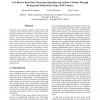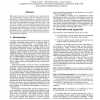AVSS
2005
IEEE
14 years 5 months ago
2005
IEEE
This paper proposes a frequency method to estimate the state open or closed of eye and mouth and to detect associated motion events such as blinking and yawning. The context of th...
AVSS
2005
IEEE
14 years 5 months ago
2005
IEEE
Nowadays, many visual surveillance systems exploit PTZ camera to increase the field of view of a surveyed area. The background subtraction technique is widespread to detect movin...
AVSS
2005
IEEE
14 years 5 months ago
2005
IEEE
Distributed video coding (DVC) is a new coding paradigm that enables to exploit video statistics, partially or totally at the decoder. A particular case of DVC, Wyner-Ziv coding, ...
AVSS
2005
IEEE
14 years 5 months ago
2005
IEEE
In this paper, we present a video encoding scheme that uses object-based adaptation to deliver surveillance video to mobile devices. The method relies on a set of complementary vi...
AVSS
2005
IEEE
14 years 5 months ago
2005
IEEE
This paper describes the architecture of a visual surveillance system that combines real time computer vision algorithms with logic programming to represent and recognize activiti...
AVSS
2005
IEEE
14 years 5 months ago
2005
IEEE
Until recently, traditional approaches to the task of camera calibration have relied on the use of accurate grid patterns, or strategically placed targets. Such approaches can pro...
AVSS
2005
IEEE
14 years 5 months ago
2005
IEEE
This paper presents a new approach for tracking objects in complex situations such as people in a crowd or players on a soccer field. Each object in the image is represented by s...
AVSS
2005
IEEE
14 years 5 months ago
2005
IEEE
Image-based rendering (IBR) is an emerging technology for photo-realistic rendering of scenes from a collection of densely sampled images and videos. Recently, an object-based app...
AVSS
2005
IEEE
14 years 5 months ago
2005
IEEE
In video surveillance projects, automatic and realtime event detection solutions are required to guarantee an efficient and cost-effective use of the infrastructure. Many solution...
AVSS
2005
IEEE
14 years 5 months ago
2005
IEEE
A significant problem in scene interpretation is efficient bottom-up extraction and representation of salient features. In this paper, we address the problem of correlating sali...


